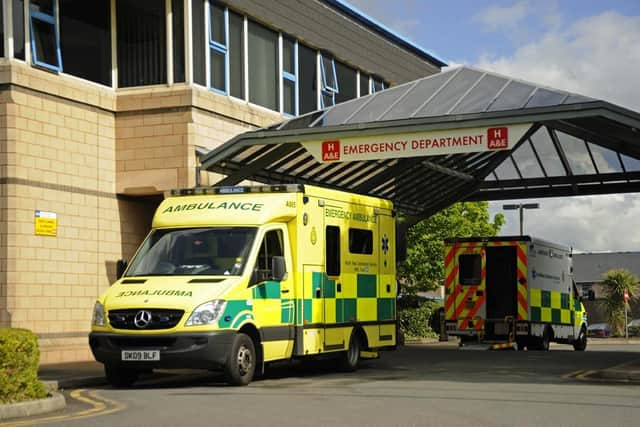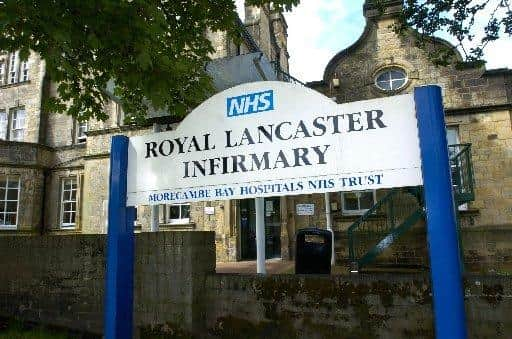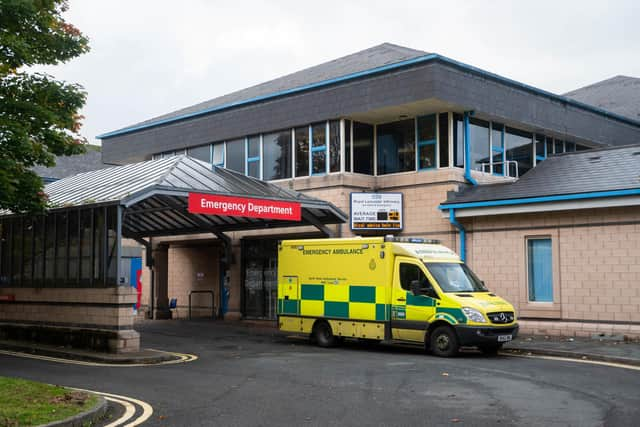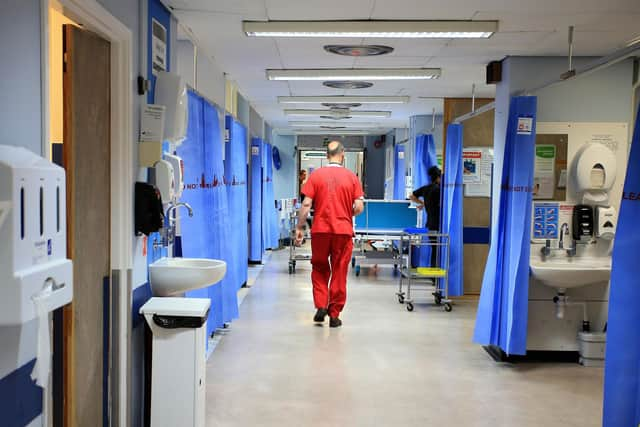‘People die waiting for ambulances’ and the ‘hell’ of A&E – two personal accounts of a terrifying crisis on the NHS frontline in Lancaster
and live on Freeview channel 276
And one Morecambe resident has told how she waited in an ambulance outside the Royal Lancaster Infirmary for eight hours before her elderly aunt was treated after a fall.
Both hospital and ambulance services have been making the news headlines in recent weeks, with seriously ill patients waiting hours for ambulances as emergency 999 calls stack up, while many ambulance staff are working entire shifts queuing outside hospitals as there are no beds available inside for people needing to be dropped off.
Advertisement
Hide AdAdvertisement
Hide AdParamedics, call handlers, emergency care assistants and other ambulance workers have recently voted in their masses to strike.


But paramedics have said it’s hoped strikes will finally ensure that ambulance services up and down the country are fit for purpose.
The chaos comes amid latest figures which show that most areas, including Lancaster, are failing to meet NHS target response times.
Here we tell the experiences of people on both sides of the story in Lancaster.
Advertisement
Hide AdAdvertisement
Hide AdThe ambulance driver


One Morecambe Bay ambulance driver has wished people ‘good luck’ if they need to call an ambulance.
The driver, who wished to remain anonymous, said: “People are dying in the ambulances as there is no room inside the hospitals.
“If we can get the ambulance to the homes...we can't offload the case at the hospital as they have eight beds...always full...the corridors are always full.
“I sat on Friday night with eight other ambulances. Nowhere to put them, patients died in the ambulances. Patents die waiting for ambulances.
Advertisement
Hide AdAdvertisement
Hide Ad

“To work in A&E itself is hell - every shift you walk into a living nightmare. Patients are shouting how disgraceful it is as if we don't already know, like it's our fault.
“It's not a good place to come to work. We know it's unacceptable but what can we do?
“It really is an appalling set-up which needs looking at and making public an unacceptable situation or nothing gets done.
“If anyone needs an ambulance then good luck with that.”


The patient’s relative
Patricia Williams waited more than eight hours in an ambulance overnight on Tuesday December 27 for her 89-year-old aunt to be admitted to the Royal Lancaster Infirmary after a fall.
This was after a six-hour wait for the ambulance to arrive.
Advertisement
Hide AdAdvertisement
Hide AdAs they queued she witnessed up to nine ambulances waiting at any one time, with A&E full at all times and some patients waiting in corridors for treatment or beds.
Paramedics skipped breaks and ate their meals as they worked, some having to share patients waiting in ambulances as other staff ended their shifts.
Patricia, who lives in Heysham, has praised the ‘excellent’ care her aunt received throughout the process, and said she “couldn’t stress how wonderful they were and the care we received was fabulous, dignified and respectful.”


Her aunt has now undergone successful surgery on her hip and is recovering well in hospital.
Advertisement
Hide AdAdvertisement
Hide AdPatricia said: “I like many others have watched news coverage about the NHS and the problems in the accident and emergency services.
"On December 27 I witnessed this personally; my aunt had a bad fall which happened to be outside a local pub. Three people came running out to help, showing how we as a nation are always willing to help when needed, and managed to get her indoors. We called 999 at 3pm.
"We had done what we had been told, explored others ways of getting to hospital, but this was impossible to do with the pain she was in.
“We were told it could be up to 14 hours before we got help; at this point my aunt was on a chair, in pain and uncomfortable.
Advertisement
Hide AdAdvertisement
Hide Ad“For anybody waiting like this you will recognise the feelings we had – helplessness, the pacing and the endless looking out of the window waiting for the familiar blue lights.
“We had to ring back three times when the pain got worse and symptoms changed. Eventually they arrived and it was evident from the start the care we got was going to be excellent.
“This ambulance had been diverted from Preston as after six hours there was still no ambulance available locally. After carefully and thoroughly checking my aunt over we started the journey to hospital.
“As we arrived, I noticed through the camera feed the flashing blue lights as we arrived at the Royal Lancaster Infirmary but I wasn’t prepared for what I saw when I left the ambulance for some air about an hour later - there were nine ambulances parked up, their lights on, most were still flashing giving the air a blue tinge, but everything was quiet, a very eerie feeling.“At this point I have to say how lovely and attentive the crew were. I asked them about the delays and what was going on - at first they were reluctant to talk, not wanting to seem biased or militant, but over the next few hours they opened up.
Advertisement
Hide AdAdvertisement
Hide Ad“They had been delayed before, up to three hours had been their longest. They told me they had enough staff to cover the shifts - in fact Preston had taken on some newly qualified paramedics, but the problem was with capacity and the lack of money being invested.
“The old buildings were built 40 years or so ago and not thought about building in room for growth. We are all living longer and need more care.
“It was obvious their passion for their jobs and the NHS, but were frustrated they couldn’t answer calls. It made me wonder how many more people could have been helped whilst we were sat in the ambulance.
“As the hours wore on their care continued to be wonderful in a difficult situation, even for me, making me coffees from their facilities through the night.
Advertisement
Hide AdAdvertisement
Hide Ad“The ambulances didn’t decrease as the night wore on; I noticed crew eating food whilst still on duty, no breaks. I said to the crew ‘you need to look after yourselves or who will look after us, you need food and drink’, but the situation meant they had to grab this as they worked.
“At about 1pm I was told the managers had been called in for meetings; the crew said there were options – cohorting was one, which means one ambulance crew would look after a number of patients within the hospital, freeing up a couple of ambulances, but this was impossible as there were no trolleys left in the hospital and no free beds.“It became obvious the crew were not comfortable with talking about it but the problem is not only wages but a general lack of investment in the system, although I was told one of the experienced crew was earning under £14 an hour and she was at the top of the increments and could not go any higher.
“This may seem ok but they are saving our lives! It is also the conditions, think about a 12 hour shift, no breaks, you are looking after very poorly patients, you could be unable to finish at the correct time if you are with a patient and then you may have up to an hour’s drive to get back to base – dangerous when you are exhausted.
“At one point I realised from conversations one crew had to clock off after working past their hours and two ambulances had one crew looking after both.
Advertisement
Hide AdAdvertisement
Hide Ad“We also need to be educated – the crew told me of people calling ambulances for a couple of hours of vomiting and small injuries, certainly not emergencies.
“It was no different in the hospital. I went to the toilet and found the corridor full of trolleys and wheelchairs, patients dozing. How can these people be monitored properly when the nurses have the cubicles full of patients too?
“Whilst inside I overheard one nurse turn to another and say “I am overwhelmed” - I did not know the context admittedly but assumed this is how she felt looking around.
“Eventually after eight hours at 7.15am, after their clock-off time, our crew were relieved by a crew who had travelled from Preston but then they faced the 30 mile trip back to base before they could finish their shift. I can’t stress how wonderful they were and the care we received was fabulous, dignified and respectful.
Advertisement
Hide AdAdvertisement
Hide Ad“We eventually entered the building at 8am, nine hours after we arrived at A&E. Again the care was second to none, attentive and with respect and care.
“My aunt was diagnosed with a broken hip and stayed in A&E; later that day we were told there were no beds and my aunt would stay on A&E but if the cubicle was needed she would be put on the corridor. I was horrified.
“Again we arranged for a full night in the unit; luckily she got a bed - sad when you realise from what a nurse told us it was possible a bed would only come empty when someone died.
“We left the unit at 6pm [on Wednesday December 28] and still the corridors were full - at least 15 trolleys along two corridors and four ambulances outside.
Advertisement
Hide AdAdvertisement
Hide Ad“One lady on a trolley had been there the first time I entered during the night; how long she had been there or when she left, I don’t know but it makes me sad.
“I want to thank all the staff in the ambulance and Accident and Emergency department, they are amazing and I feel if we don’t look after them and invest more in the system, we might lose these people.
“Where would we be without them?"
The facts
Latest figures show that most areas are failing to meet NHS target response times.
Category one calls cover the most life-threatening injuries and have a target average response time of seven minutes.
Advertisement
Hide AdAdvertisement
Hide AdLancaster district currently has an average of 8m 29s (2021/22 figures).
For category two (serious incidents such as heart attacks and strokes), Lancaster’s latest figure is 29m 24s, against a target of 18 minutes.
In addition, new figures show that across England, more patients waited in an ambulance for more than an hour than at any stage last winter.
NHS England figures show 69 patients waited in an ambulance for at least one hour when they arrived at University Hospitals of Morecambe Bay NHS Foundation Trust A&E in the week to December 4 – up from 25 the week before.
Advertisement
Hide AdAdvertisement
Hide AdA further 49 patients were forced to wait between 30 minutes and one hour, meaning 22% of the 530 total ambulance arrivals were delayed by half an hour or more, and at least 125 hours were lost.
NHS targets state trusts should complete 95% of all ambulance handovers in 30 minutes, with all conducted in less than one hour.
An NHS spokesman said: “The NHS is working with the parts of the country facing the greatest challenges to provide additional support and has taken steps to prepare for winter like never before – rolling out a national falls service, increasing the number of call handlers and boosting hospital bed capacity by the equivalent of 7,000 beds – it however remains important for anyone who needs life-saving care to continue to dial 999 in an emergency and use 111 online for other health needs.”